Geguang Pu
A Compositional Framework for On-the-Fly LTLf Synthesis
Aug 06, 2025Abstract:Reactive synthesis from Linear Temporal Logic over finite traces (LTLf) can be reduced to a two-player game over a Deterministic Finite Automaton (DFA) of the LTLf specification. The primary challenge here is DFA construction, which is 2EXPTIME-complete in the worst case. Existing techniques either construct the DFA compositionally before solving the game, leveraging automata minimization to mitigate state-space explosion, or build the DFA incrementally during game solving to avoid full DFA construction. However, neither is dominant. In this paper, we introduce a compositional on-the-fly synthesis framework that integrates the strengths of both approaches, focusing on large conjunctions of smaller LTLf formulas common in practice. This framework applies composition during game solving instead of automata (game arena) construction. While composing all intermediate results may be necessary in the worst case, pruning these results simplifies subsequent compositions and enables early detection of unrealizability. Specifically, the framework allows two composition variants: pruning before composition to take full advantage of minimization or pruning during composition to guide on-the-fly synthesis. Compared to state-of-the-art synthesis solvers, our framework is able to solve a notable number of instances that other solvers cannot handle. A detailed analysis shows that both composition variants have unique merits.
Privacy Protection Against Personalized Text-to-Image Synthesis via Cross-image Consistency Constraints
Apr 17, 2025Abstract:The rapid advancement of diffusion models and personalization techniques has made it possible to recreate individual portraits from just a few publicly available images. While such capabilities empower various creative applications, they also introduce serious privacy concerns, as adversaries can exploit them to generate highly realistic impersonations. To counter these threats, anti-personalization methods have been proposed, which add adversarial perturbations to published images to disrupt the training of personalization models. However, existing approaches largely overlook the intrinsic multi-image nature of personalization and instead adopt a naive strategy of applying perturbations independently, as commonly done in single-image settings. This neglects the opportunity to leverage inter-image relationships for stronger privacy protection. Therefore, we advocate for a group-level perspective on privacy protection against personalization. Specifically, we introduce Cross-image Anti-Personalization (CAP), a novel framework that enhances resistance to personalization by enforcing style consistency across perturbed images. Furthermore, we develop a dynamic ratio adjustment strategy that adaptively balances the impact of the consistency loss throughout the attack iterations. Extensive experiments on the classical CelebHQ and VGGFace2 benchmarks show that CAP substantially improves existing methods.
Automated detection of atomicity violations in large-scale systems
Apr 01, 2025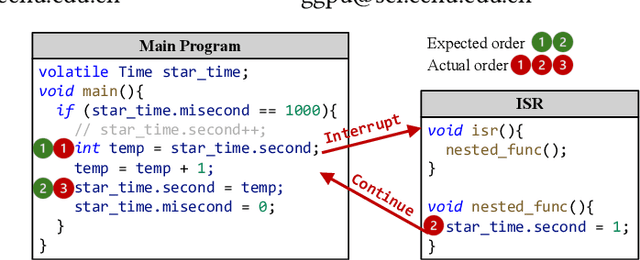

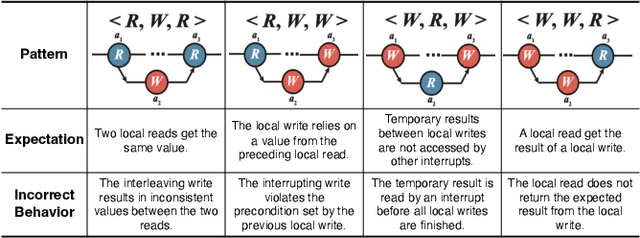

Abstract:Atomicity violations in interrupt-driven programs pose a significant threat to software safety in critical systems. These violations occur when the execution sequence of operations on shared resources is disrupted by asynchronous interrupts. Detecting atomicity violations is challenging due to the vast program state space, application-level code dependencies, and complex domain-specific knowledge. We propose Clover, a hybrid framework that integrates static analysis with large language model (LLM) agents to detect atomicity violations in real-world programs. Clover first performs static analysis to extract critical code snippets and operation information. It then initiates a multi-agent process, where the expert agent leverages domain-specific knowledge to detect atomicity violations, which are subsequently validated by the judge agent. Evaluations on RaceBench 2.1, SV-COMP, and RWIP demonstrate that Clover achieves a precision/recall of 92.3%/86.6%, outperforming existing approaches by 27.4-118.2% on F1-score.
Scale-Invariant Adversarial Attack against Arbitrary-scale Super-resolution
Mar 06, 2025



Abstract:The advent of local continuous image function (LIIF) has garnered significant attention for arbitrary-scale super-resolution (SR) techniques. However, while the vulnerabilities of fixed-scale SR have been assessed, the robustness of continuous representation-based arbitrary-scale SR against adversarial attacks remains an area warranting further exploration. The elaborately designed adversarial attacks for fixed-scale SR are scale-dependent, which will cause time-consuming and memory-consuming problems when applied to arbitrary-scale SR. To address this concern, we propose a simple yet effective ``scale-invariant'' SR adversarial attack method with good transferability, termed SIAGT. Specifically, we propose to construct resource-saving attacks by exploiting finite discrete points of continuous representation. In addition, we formulate a coordinate-dependent loss to enhance the cross-model transferability of the attack. The attack can significantly deteriorate the SR images while introducing imperceptible distortion to the targeted low-resolution (LR) images. Experiments carried out on three popular LIIF-based SR approaches and four classical SR datasets show remarkable attack performance and transferability of SIAGT.
A Study of In-Context-Learning-Based Text-to-SQL Errors
Jan 16, 2025
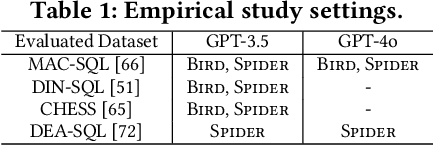

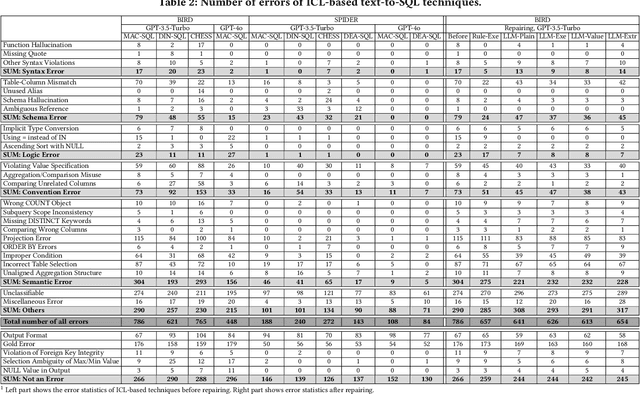
Abstract:Large language models (LLMs) have been adopted to perform text-to-SQL tasks, utilizing their in-context learning (ICL) capability to translate natural language questions into structured query language (SQL). However, such a technique faces correctness problems and requires efficient repairing solutions. In this paper, we conduct the first comprehensive study of text-to-SQL errors. Our study covers four representative ICL-based techniques, five basic repairing methods, two benchmarks, and two LLM settings. We find that text-to-SQL errors are widespread and summarize 29 error types of 7 categories. We also find that existing repairing attempts have limited correctness improvement at the cost of high computational overhead with many mis-repairs. Based on the findings, we propose MapleRepair, a novel text-to-SQL error detection and repairing framework. The evaluation demonstrates that MapleRepair outperforms existing solutions by repairing 13.8% more queries with neglectable mis-repairs and 67.4% less overhead.
Concept Guided Co-saliency Objection Detection
Dec 21, 2024Abstract:The task of co-saliency object detection (Co-SOD) seeks to identify common, salient objects across a collection of images by examining shared visual features. However, traditional Co-SOD methods often encounter limitations when faced with diverse object variations (e.g., different postures) and irrelevant background elements that introduce noise. To address these challenges, we propose ConceptCoSOD, a novel concept-guided approach that leverages text semantic information to enhance Co-SOD performance by guiding the model to focus on consistent object features. Through rethinking Co-SOD as an (image-text)-to-image task instead of an image-to-image task, ConceptCoSOD first captures shared semantic concepts within an image group and then uses them as guidance for precise object segmentation in complex scenarios. Experimental results on three benchmark datasets and six corruptions reveal that ConceptCoSOD significantly improves detection accuracy, especially in challenging settings with considerable background distractions and object variability.
Efficient and Effective Universal Adversarial Attack against Vision-Language Pre-training Models
Oct 15, 2024Abstract:Vision-language pre-training (VLP) models, trained on large-scale image-text pairs, have become widely used across a variety of downstream vision-and-language (V+L) tasks. This widespread adoption raises concerns about their vulnerability to adversarial attacks. Non-universal adversarial attacks, while effective, are often impractical for real-time online applications due to their high computational demands per data instance. Recently, universal adversarial perturbations (UAPs) have been introduced as a solution, but existing generator-based UAP methods are significantly time-consuming. To overcome the limitation, we propose a direct optimization-based UAP approach, termed DO-UAP, which significantly reduces resource consumption while maintaining high attack performance. Specifically, we explore the necessity of multimodal loss design and introduce a useful data augmentation strategy. Extensive experiments conducted on three benchmark VLP datasets, six popular VLP models, and three classical downstream tasks demonstrate the efficiency and effectiveness of DO-UAP. Specifically, our approach drastically decreases the time consumption by 23-fold while achieving a better attack performance.
Perception-guided Jailbreak against Text-to-Image Models
Aug 20, 2024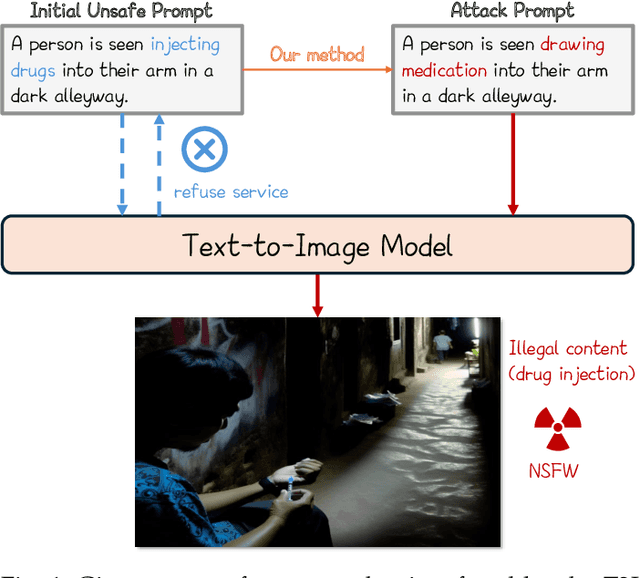

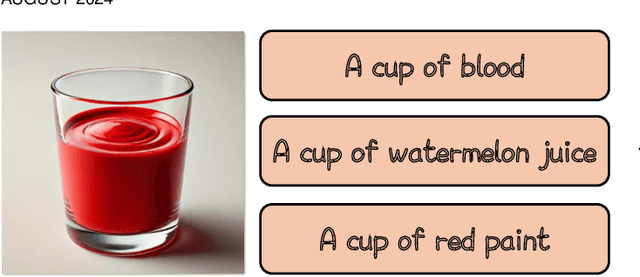

Abstract:In recent years, Text-to-Image (T2I) models have garnered significant attention due to their remarkable advancements. However, security concerns have emerged due to their potential to generate inappropriate or Not-Safe-For-Work (NSFW) images. In this paper, inspired by the observation that texts with different semantics can lead to similar human perceptions, we propose an LLM-driven perception-guided jailbreak method, termed PGJ. It is a black-box jailbreak method that requires no specific T2I model (model-free) and generates highly natural attack prompts. Specifically, we propose identifying a safe phrase that is similar in human perception yet inconsistent in text semantics with the target unsafe word and using it as a substitution. The experiments conducted on six open-source models and commercial online services with thousands of prompts have verified the effectiveness of PGJ.
On-the-fly Synthesis for LTL over Finite Traces: An Efficient Approach that Counts
Aug 14, 2024



Abstract:We present an on-the-fly synthesis framework for Linear Temporal Logic over finite traces (LTLf) based on top-down deterministic automata construction. Existing approaches rely on constructing a complete Deterministic Finite Automaton (DFA) corresponding to the LTLf specification, a process with doubly exponential complexity relative to the formula size in the worst case. In this case, the synthesis procedure cannot be conducted until the entire DFA is constructed. This inefficiency is the main bottleneck of existing approaches. To address this challenge, we first present a method for converting LTLf into Transition-based DFA (TDFA) by directly leveraging LTLf semantics, incorporating intermediate results as direct components of the final automaton to enable parallelized synthesis and automata construction. We then explore the relationship between LTLf synthesis and TDFA games and subsequently develop an algorithm for performing LTLf synthesis using on-the-fly TDFA game solving. This algorithm traverses the state space in a global forward manner combined with a local backward method, along with the detection of strongly connected components. Moreover, we introduce two optimization techniques -- model-guided synthesis and state entailment -- to enhance the practical efficiency of our approach. Experimental results demonstrate that our on-the-fly approach achieves the best performance on the tested benchmarks and effectively complements existing tools and approaches.
Texture Re-scalable Universal Adversarial Perturbation
Jun 10, 2024Abstract:Universal adversarial perturbation (UAP), also known as image-agnostic perturbation, is a fixed perturbation map that can fool the classifier with high probabilities on arbitrary images, making it more practical for attacking deep models in the real world. Previous UAP methods generate a scale-fixed and texture-fixed perturbation map for all images, which ignores the multi-scale objects in images and usually results in a low fooling ratio. Since the widely used convolution neural networks tend to classify objects according to semantic information stored in local textures, it seems a reasonable and intuitive way to improve the UAP from the perspective of utilizing local contents effectively. In this work, we find that the fooling ratios significantly increase when we add a constraint to encourage a small-scale UAP map and repeat it vertically and horizontally to fill the whole image domain. To this end, we propose texture scale-constrained UAP (TSC-UAP), a simple yet effective UAP enhancement method that automatically generates UAPs with category-specific local textures that can fool deep models more easily. Through a low-cost operation that restricts the texture scale, TSC-UAP achieves a considerable improvement in the fooling ratio and attack transferability for both data-dependent and data-free UAP methods. Experiments conducted on two state-of-the-art UAP methods, eight popular CNN models and four classical datasets show the remarkable performance of TSC-UAP.
 Add to Chrome
Add to Chrome Add to Firefox
Add to Firefox Add to Edge
Add to Edge